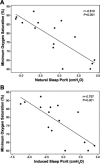Critical closing pressure during midazolam-induced sleep
- PMID: 21852408
- PMCID: PMC3774482
- DOI: 10.1152/japplphysiol.00508.2011
Critical closing pressure during midazolam-induced sleep
Abstract
The critical closing pressure (Pcrit) is the airway pressure at which the airway collapses and reflects the anatomical contribution to the genesis of obstructive sleep apnea. Pcrit is usually determined during non-rapid eye movement sleep at night, but has been determined under midazolam sedation during the day in the absence of sleep stage monitoring. Indeed, little is known about the effects of midazolam on sleep architecture. Moreover, deeper sedation with midazolam can decrease upper airway muscle activity and increase collapsibility compared with natural sleep. Pcrit under sedation has not been systematically compared with the usual method performed during natural sleep. Therefore, this study aimed to test the hypothesis that Pcrit following low doses of midazolam during the day would be comparable to Pcrit measured during natural sleep in the same patient. Fifteen men (age 54 ± 10 yr, body mass index 30 ± 4 kg/m(2)) with obstructive sleep apnea underwent a baseline standard overnight polysomnogram (apnea-hypopnea index 38 ± 22 events/h, range: 8-66 events/h), and Pcrit was determined during natural sleep and following midazolam. Sleep induction was obtained with low doses of midazolam (2.4 mg, range 2.0-4.4 mg), and sleep architecture was comparable to natural sleep. Natural sleep and induced sleep Pcrit were similar (-0.82 ± -3.44 and -0.97 ± 3.21 cmH(2)O, P = 0.663) and closely associated (intraclass correlation coefficient = 0.92; 95% confidence interval, 0.78-0.97, P < 0.001). Natural and midazolam-induced Pcrit correlated with obstructive sleep apnea severity, indicating that both Pcrit measures provided meaningful physiological information. Pcrit determined during the day with sleep induction is similar to natural overnight sleep and is a valid alternative approach in which to determine Pcrit.
Figures






Similar articles
-
Upper Airway Reflexes are Preserved During Dexmedetomidine Sedation in Children With Down Syndrome and Obstructive Sleep Apnea.J Clin Sleep Med. 2017 May 15;13(5):721-727. doi: 10.5664/jcsm.6592. J Clin Sleep Med. 2017. PMID: 28356179 Free PMC article.
-
Upper Airway Collapsibility Assessed by Negative Expiratory Pressure while Awake is Associated with Upper Airway Anatomy.J Clin Sleep Med. 2016 Oct 15;12(10):1339-1346. doi: 10.5664/jcsm.6184. J Clin Sleep Med. 2016. PMID: 27448414 Free PMC article.
-
Contribution of male sex, age, and obesity to mechanical instability of the upper airway during sleep.J Appl Physiol (1985). 2008 Jun;104(6):1618-24. doi: 10.1152/japplphysiol.00045.2008. Epub 2008 Apr 17. J Appl Physiol (1985). 2008. PMID: 18420722 Free PMC article.
-
Critical to Know Pcrit: A Review on Pharyngeal Critical Closing Pressure in Obstructive Sleep Apnea.Front Neurol. 2022 Feb 22;13:775709. doi: 10.3389/fneur.2022.775709. eCollection 2022. Front Neurol. 2022. PMID: 35273554 Free PMC article. Review.
-
Assessment of upper airway mechanics during sleep.Respir Physiol Neurobiol. 2008 Nov 30;163(1-3):74-81. doi: 10.1016/j.resp.2008.06.017. Epub 2008 Jun 27. Respir Physiol Neurobiol. 2008. PMID: 18638576 Review.
Cited by
-
Feasibility of upper airway collapsibility measurements in anesthetized children.Paediatr Anaesth. 2023 Mar;33(3):263-265. doi: 10.1111/pan.14603. Epub 2022 Nov 28. Paediatr Anaesth. 2023. PMID: 36398409 Free PMC article. No abstract available.
-
Comparison of upper airway obstruction during zolpidem-induced sleep and propofol-induced sleep in patients with obstructive sleep apnea: a pilot study.J Clin Sleep Med. 2020 May 15;16(5):725-732. doi: 10.5664/jcsm.8334. Epub 2020 Feb 7. J Clin Sleep Med. 2020. PMID: 32029070 Free PMC article.
-
Patients' preferences and the efficacy of a hybrid model of a minimal contact nasal mask in patients with sleep apnea treated with CPAP.Sleep Sci. 2018 Jul-Aug;11(4):254-259. doi: 10.5935/1984-0063.20180040. Sleep Sci. 2018. PMID: 30746043 Free PMC article.
-
Dexmedetomidine versus propofol during drug-induced sleep endoscopy and sedation: a systematic review.Sleep Breath. 2017 Sep;21(3):727-735. doi: 10.1007/s11325-017-1465-x. Epub 2017 Jan 27. Sleep Breath. 2017. PMID: 28130737
-
A Novel Model to Estimate Key Obstructive Sleep Apnea Endotypes from Standard Polysomnography and Clinical Data and Their Contribution to Obstructive Sleep Apnea Severity.Ann Am Thorac Soc. 2021 Apr;18(4):656-667. doi: 10.1513/AnnalsATS.202001-064OC. Ann Am Thorac Soc. 2021. PMID: 33064953 Free PMC article.
References
-
- Ayuse T, Inazawa T, Kurata S, Okayasu I, Sakamoto E, Oi K, Schneider H, Schwartz AR. Mouth-opening increases upper-airway collapsibility without changing resistance during midazolam sedation. J Dent Res 83: 718–722, 2004 - PubMed
-
- Chan AS, Lee RW, Srinivasan VK, Darendeliler MA, Grunstein RR, Cistulli PA. Nasopharyngoscopic evaluation of oral appliance therapy for obstructive sleep apnoea. Eur Respir J 35: 836–842, 2010 - PubMed
-
- Cooper AB, Thornley KS, Young GB, Slutsky AS, Stewart TE, Hanly PJ. Sleep in critically ill patients requiring mechanical ventilation. Chest 117: 809–818, 2000 - PubMed
MeSH terms
Substances
Grants and funding
LinkOut - more resources
Full Text Sources

